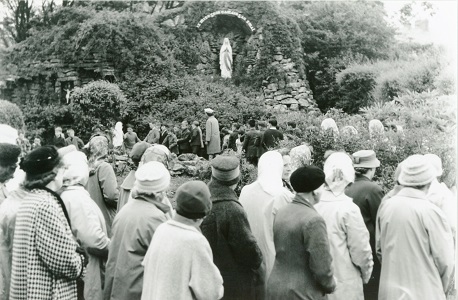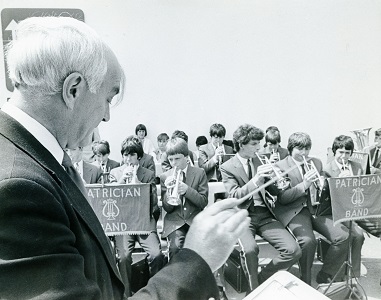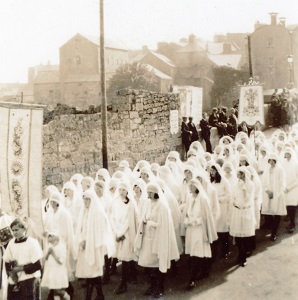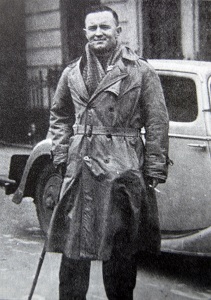Old Galway
THE GROTTO OF OUR LADY OF LOURDES

by Tom Kenny
A Grotto is a natural or artificial cave used by humans in modern times and antiquity. Today, they are often used as shrines in which to place statues of saints, particularly the Virgin Mary. The Grotto of Our Lady of Lourdes stood in the southwest corner of the grounds of St. Patrick’s Church.
“High in the rockery, standing in the nook, stood the statue of Our Lady, her eyes raised heavenwards. In every season, the rockery was a cornucopia of colour; purple pansies, pink ground roses, evergreen of every hue. Hyacinth, snowdrops in spring, viola and gold marigolds in autumn. Surrounding the grotto was a white-painted stone altar rail, broken at the corner by a locked wooden gate which was painted blue. To linger in the grotto was to be in silence. The passing traffic, the noise of the altar boys playing ‘tag’ around the church never seemed to disturb the tranquillity of the sacred space.
SHANGORT, KNOCKNACARRA

by Tom Kenny
This photograph of the Shangort area of Knocknacarra was originally taken in the 1950’s by Aodh MacDúbháin, a teacher in St. Enda’s who did a lot of work with An Taidhbhearc. It was taken from Carragh Hill.
On the left we see Joyce’s house which was later occupied by Whytes. Tucked in behind it was Finnerans. Going right was Heneghans, later O’Flynns and later still Murrays. Next door was Hambroges, later occupied by Garavans, Conneelys and then Kellys. Beside that was McGuanes (Mac Dúbháin) which later became Doyles, McDonaghs and then Gillespies. The white house behind that was Greens, and to the right of that, in the distance, what looks like a thatched house was Fahertys.
THE PATRICIAN BOYS BRASS BAND

by Tom Kenny
When you think of it, the Patrician Brothers have made a major impact on the city of Galway since they came here. This has been particularly evident in the music world of the city; they set up a Fife and Drum Band well over a century ago; they have trained countless choirs down through the years which in turn led to the formation of the Patrician Musical Society; They have formed many céilí bands, teaching the boys to play the accordion, the flageolet, the moth organ, the triangle, the drums and castanets. There was such a demand for these céilí groups at civic functions that the brothers decided to put their best foot forward and form a brass band.
THE CORPUS CHRISTI PROCESSION

by Tom Kenny
“Upwards of seven thousand people took part in the annual Eucharistic Procession through the streets of Galway on Sunday, when one of the greatest demonstrations of faith in recent years was seen. Practically all of that part of the city’s population which did not take part, thronged the footpaths, and when the procession arrived at Eyre Square at six o’clock, upwards of ten thousand people knelt on the green sward in front of the specially constructed high altar for the final Benediction, which was imparted by his Lordship, Most Rev. Dr. Browne.
Gentian Hill

by Tom Kenny
The correct name for this promontory is Blake’s Hill which comprises approximately 30 acres. Gentian Hill was a much smaller area further north, but nowadays the whole area is referred to as Gentian Hill. An extract from O’Donovan’s Letters described it as follows: “Here in Blake’s Hill over the sea, whither the young men of Galway were wont to come on horseback on the third day of their May game, and there dine between the hill and the castle of Barna. Sir Moragh O’Flaherty of Aughamore defeated an army out of Clanricard on the 22nd of June 1564 on the strand at Traybane, Cnoc an Blacaigh.”
LORD HAW-HAW, THE EARLY YEARS

by Tom Kenny
In 1915, a short fair-haired blue-eyed boy was sent to the Jes. He later recalled the staff and the pupils as being tough. Latin was supreme and an excitable Latin teacher banged boys’ heads on the radiator. The Jesuits instilled in him a sense of discipline and an acceptance of punishment, and they left him with a love of language --- his classmates would note how he used big and strange words --- as well as a passion for debate. His uncle Gilbert once remarked “The boy had a strong tendency to argue with his teachers”.
Poorhouse from Galway

by Tom Kenny
“With giant strides destitution and misery progress – the wants of the people daily and hourly progress --- the cries for succour and assistance go forth, and ere long, even now, the distress of the poor has attained a degree fearful to contemplate. Turn to what quarter we may, the same dismal tale is told to us --- in every direction we see countenance wan with care and hunger. In a like condition are the inhabitants of the rural districts, and we find that parishes --- Annadown for instance, which used to supply the markets of Galway so abundantly, after supporting its own people in comfort, are now reduced to a most pitiable condition. There indeed, some of the landlords, at least those who reside at home, have stepped forward seasonably to the relief of their fellow creatures, and headed by the Cregg family, ever remarkable for their benevolence, seem resolved to do their duty”.
MICHAEL NEWELL

by Tom Kenny
Michael was born near Headford, went to school in Roscrea where he played rugby for the school. He emigrated to New Zealand for a while before returning to Galway to take over a premises on Sea Road that had been occupied by Dan Whyte the barber, and his daughter Rita who taught Irish dancing there. He set up an ice cream parlour that became a great haunt for local teenagers. He made his own ice cream and ice pops but the biggest attraction was the novel (for the time) milk shakes that he made, and then topped them of with strawberries or raspberries or some other fruit. “It was almost impossible to look in the window without feeling a huge need for an ice cream”. He would roll up a piece of paper into the shape of a cone, put a twist on the end of it and pop a measured number of bulls eyes into it, a process which always fascinated the kids. He was ahead of his time but he was not really a businessman.
.png)